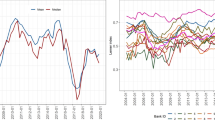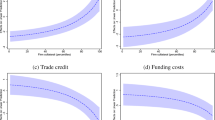Abstract
This paper demonstrates that the financial conditions of US subsidiaries, and not those of their owners, have been the primary drivers of their lending since the mid-1990s. This evidence is obtained by using a large number of bank-level observations from US Call Reports. The ownership structure inferred from these data allows for a unique identification strategy that determines the independent effects of subsidiary-specific and owner-specific financial conditions on subsidiaries’ lending. The results show that subsidiaries’ financial conditions were, in general, more important for lending decisions than those of their owners in the past two decades. Considering a broad set of factors with systematic effects on financial markets, the paper also finds that these so-called push factors influence subsidiaries’ lending mainly through their own financial conditions and not those of their owners.
Similar content being viewed by others
Notes
Conlon and Cotter (2019) and Karamichailidou and Mayes (2016) provide an extensive review of the differences between a single point entry bankruptcy resolution (a more universal approach that focuses on the parent bank) and a multiple points entry resolution (a more territorial approach that focuses on the subsidiaries). The authors point out the growing emphasis on subsidiaries for internationally active banks in the past decade. For banks that only lend domestically, especially in the USA and after 2008, bankruptcy resolution follows a single point entry model.
The evidence suggests that management practices within banks’ internal network have remained symmetric with a high degree of information sharing and common risk management practices. This indicates that the decentralization of banking is not due to management practices (e.g., Avdjiev and Takáts 2016).
Research on monetary transmission typically includes 8 lags of the monetary policy stance variable. While I do not study monetary transmission, I did replicate my analysis with 8 lags. The results, available upon request, were qualitatively similar.
Structural and performance ratios are reported explicitly after 2011, for example. My approach, summarized above, allows for a more consistent analysis across the historical periods that I consider.
I use the steps in Roodman (2009) to execute this methodology in STATA.
I use the Hansen test statistic rather than the Sargan test statistic since the latter is not robust to heteroscedasticity and autocorrelation in large panels such as the one that I use in this paper.
References
Arellano M, Bover O (1995) Another look at instrumental variables estimation of error-component models. J Econ 68:29–51
Ashcraft A, Campello M (2007) Firm balance sheets and monetary policy transmission. J Monet Econ 54:1515–1528
Avdjiev S, Takáts E (2014) Cross-border bank lending during the taper tantrum: the role of emerging markets fundamentals, BIS Quarterly Review, September
Avdjiev S, Takáts E (2016) Monetary policy spillovers and currency networks in cross-border bank lending, Bank for International Settlements, Working Paper 549
Avdjiev S, Aysun U, Hepp R (2019) What drives local lending by global banks? J Int Money Finance 90(C):54–75
Berger AN, Black LK (2010) Bank size, lending technologies, and small business finance. J Bank Finance 35(3):724–735
Berger AN, Klapper L, Udell GF (2001) The ability of banks to lend to informationally opaque small businesses. J Bank Finance 25:2127–2167
Berger AN, Miller NH, Petersen MA, Rajan RG, Stein JC (2005) Does function follow organizational form? Evidence from the lending practices of large and small banks. J Financ Econ 76:237–269
Bresnahan TF, Brynjolfsson E, Hitt LM (2002) Information technology, workplace organization, and the demand for skilled labor: firm-level evidence. Q J Econ 117:399–376
Brynjolfsson E, Hitt LM (1998) Information technology and organizational design: evidence from micro data, mimeo
Buch C, Koch C, Koetter M (2016) Crises and rescues: liquidity transmission through international banks, Bank for International Settlements, Working Paper, 576
Campello M (2002) Internal capital markets in financial conglomerates: evidence from small bank responses to monetary policy. J Finance 57:2773–2805
Cerutti, EM, Claessens S, Puy D (2015) Push factors and capital flows to emerging markets: why knowing your lender matters more than fundamentals, IMF Working Paper 15/127
Cetorelli N, Goldberg L (2012a) Liquidity management of US global banks: internal capital markets in the great recession. J Int Econ 88:299–311
Cetorelli N, Goldberg L (2012b) Banking globalization and monetary transmission. J Finance 67(5):1811–1843
Cetorelli N, Goldberg L (2016) Organizational complexity and balance sheet management in global banks, Staff Reports 772, Federal Reserve Bank of New York
Claessens S (2017) Global banking: recent developments and insights from research. Rev Finance 21(4):1513–1555
Claessens S, Van Horen N (2014) Foreign banks: trends and impact. J Money Credit Bank 46(s1):295–326
Conlon T, Cotter J (2019) Subordinate resolution—an empirical analysis of European Union subsidiary banks. J Common Market Stud. https://doi.org/10.1111/jcms.12849
Crystal JS, Dages B, Goldberg L (2002) Has foreign bank entry led to sounder banks in Latin America? Federal Reserve Bank of New York. Curr Issues Econ Finance 8(1):1–6
Dages BG, Goldberg L, Kinney D (2000) Foreign and domestic bank participation in emerging markets: lessons from Mexico and Argentina. Federal Reserve Bank N Y Econ Policy Rev 6(3):17–36
De Haas R, Van Lelyveld I (2006) Foreign banks and credit stability in Central and Eastern Europe. A panel data analysis. J Bank Finance 30:1927–1952
De Haas R, Van Lelyveld I (2016) Organizational complexity and balance sheet management in (2010). Internal capital markets and lending by multi-national bank subsidiaries. J Financ Intermed 19:1–25
Federal Financial Institutions Examination Council. “Consolidated Report of Condition and Income”, Central Data Repository’s Public Data Distribution
Federal Reserve Bank of Chicago. “Consolidated Report of Condition and Income”, Data Extraction System for Call Report data
Fiechter J, Ötker-Robe I, Ilyna A, Hsu M, Santos A, Jay S (2011) Subsidiaries or branches: does One size fit all?” IMF Staff Discussion Note
Fratzscher M (2012) Capital flows, push versus pull factors and the global financial crisis. J Int Econ 88(2):341–356
Gilchrist S, Zakrajsek E (2012) Credit spreads and business cycle fluctuations. Am Econ Rev 102(4):1692–1720
Goldberg L (2002) When is U.S. Bank Lending to Emerging Markets Volatile? NBER Chapters. In: Preventing currency crises in emerging markets. National Bureau of Economic Research, Inc, pp 171–196
Houston J, Marcus D, James C (1997) Capital market frictions and the role of internal capital markets in banking. J Financ Econ 46:135–164
Houston JF, Lin C, Ma Y (2012) Regulatory arbitrage and international bank flows. J Finance 67:1845–1895
Karamichailidou G, Mayes DG (2016) Plausible recovery and resolution plans for cross-border financial institutions, European Banking Union: Prospects and Challenges. Routledge, London
Kashyap A, Stein J (2000) What do a million observations on banks say about the transmission of monetary policy? Am Econ Rev 90:407–428
Krippner L (2013) Measuring the stance of monetary policy in zero lower bound environments. Econ Lett 118:135–138
Liberti JM, Mian A (2009) Estimating the effect of hierarchies on information use. Rev Financ Stud 22:4057–4090
Liberti JM, Petersen MA (2018) Information: Hard and Soft, NBER Working Papers 25075, National Bureau of Economic Research, Inc
Martinez P, Powell A, Hollar IV (2002) Banking on foreigners: the behavior of international Bank lending to Latin America, 1985–2000, World Bank Policy Research Working Paper Series No. 2893
Miranda-Agrippino S, Rey H (2015) US Monetary policy and the global financial cycle, NBER Working Paper No. 21722
Mocetti S, Pagnini M, Sette E (2017) Information technology and banking organization. J Financ Serv Res 51:313–338
Peek J, Rosengren ES (2000) Collateral damage: effects of the Japanese bank crisis on the United States. Am Econ Rev 90:30–45
Rey H (2015) Dilemma not Trilemma: the global financial cycle and monetary policy independence, National Bureau of Economic Research Working Paper No: 21162
Roodman D (2009) How to do xtabond2: an introduction to difference and system GMM in Stata. Stata J 9(1):86–136
Skrastins J, Vig V (2019) How organizational hierarchy affects information production? Rev Financ Stud 3(2):564–604
Stein J (2002) Information production and capital allocation: decentralized versus hierarchical firms. J Finance 57:1891–1921
Strahan PE, Weston JP (1998) Small business lending and the changing structure of the banking industry. J Bank Finance 22:821–845
Takáts E (2004) Banking consolidation and small business lending, Working Paper Series 407, European Central Bank
Funding
This study did not receive any funding.
Author information
Authors and Affiliations
Corresponding author
Ethics declarations
Conflict of interest
I, Uluc Aysun, declare that I have no conflict of interest.
Ethical approval
This article does not contain any studies with human participants or animals performed by the author.
Additional information
Publisher's Note
Springer Nature remains neutral with regard to jurisdictional claims in published maps and institutional affiliations.
Appendix A: Data
Rights and permissions
About this article
Cite this article
Aysun, U. Centralized versus decentralized drivers of subsidiary lending: evidence from US Call Reports. Empir Econ 62, 1687–1714 (2022). https://doi.org/10.1007/s00181-021-02070-y
Received:
Accepted:
Published:
Issue Date:
DOI: https://doi.org/10.1007/s00181-021-02070-y




